1997 PONTIAC GRAND AM heating
[x] Cancel search: heatingPage 65 of 371
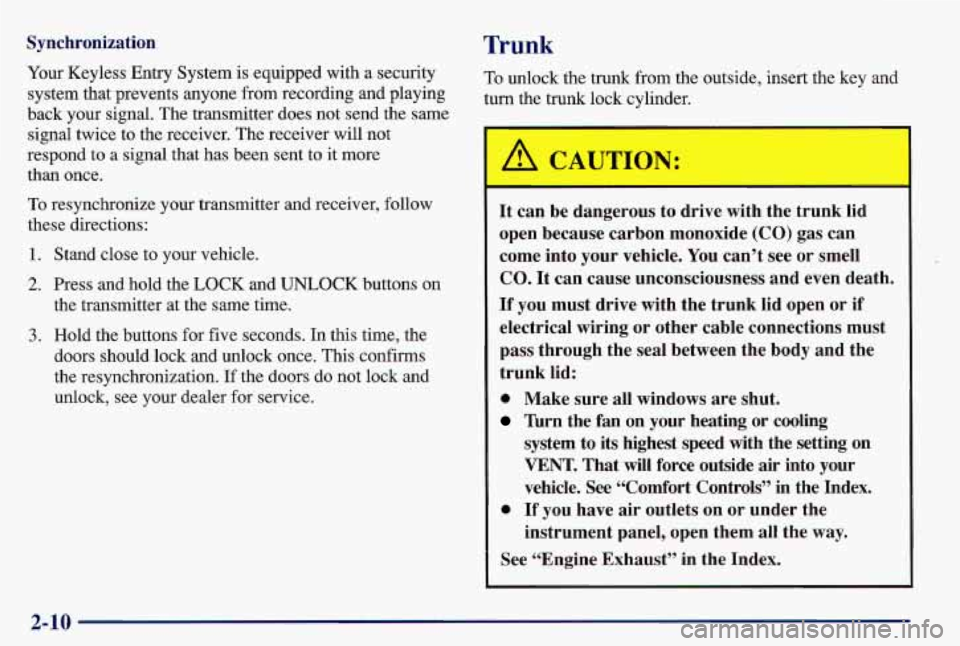
Synchronization Your Keyless Entry System is equipped with a security
system that prevents anyone from recording and playing
back your signal. The transmitter does not send the same
signal twice to the receiver. The receiver will not
respond
to a signal that has been sent to it more
than once.
Trunk
To resynchronize your transmitter and receiver, follow
these directions:
1. Stand close to your vehicle.
2. Press and hold the LOCK and UNLOCK buttons on
the transmitter at the same time.
3. Hold the buttons for five seconds. In this time, the
doors should lock and unlock once. This confirms
the resynchronization. If the doors do not lock and
unlock, see your dealer for service.
To unlock the trunk from the outside, insert the key and
turn the trunk lock cylinder.
It can be dangerous to drive with the trunk lid
open because carbon monoxide (CO) gas can
come into your vehicle.
You can’t see or smell
CO.
It can cause unconsciousness and even death.
If you must drive with the trunk lid open or if
electrical wiring or other cable connections must
pass through the seal between the body and the
trunk lid:
0 Make sure all windows are shut.
Turn the fan on your heating or cooling
system to its highest speed
with the setting on
VENT. That
will force outside air into your
vehicle. See “Comfort Controls” in the Index.
instrument panel, open them all the way.
0 If you have air outlets on or under the
See “Engine Exhaust” in the Index.
2-10
Page 107 of 371
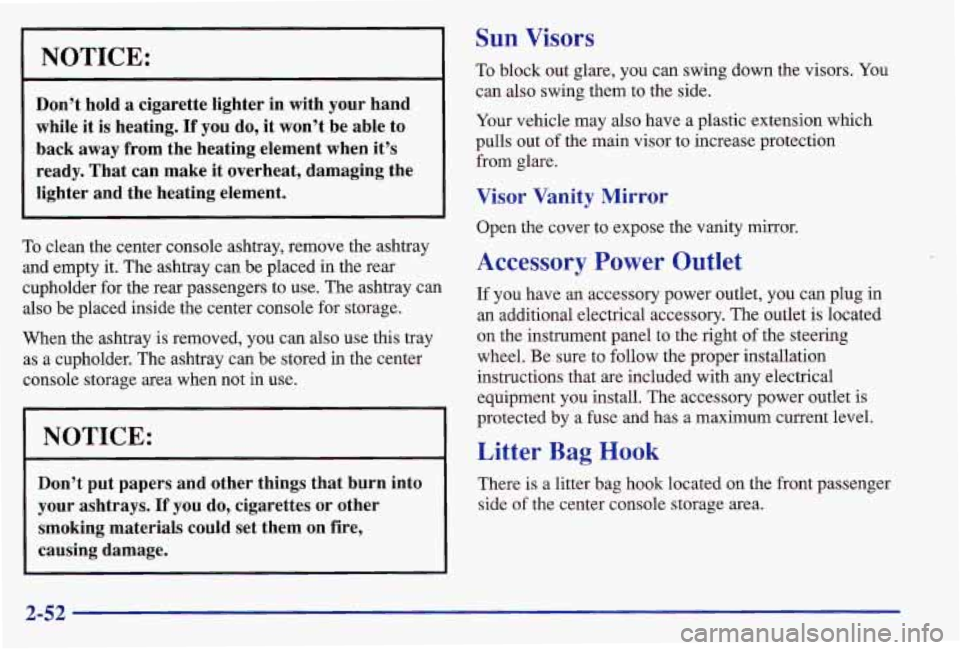
NOTICE:
Don’t hold a cigarette lighter in with your hand
while it is heating, If you do, it won’t be able to
back away from the heating element when it’s ready. That can make it overheat, damaging the
lighter and the heating element.
To clean the center console ashtray, remove the ashtray
and empty it. The ashtray can be placed
in the rear
cupholder for the rear passengers to use. The ashtray can
also be placed inside the center console for storage.
When the ashtray
is removed, you can also use this tray
as a cupholder. The ashtray can be stored in the center
console storage area when not in use.
NOTICE:
Don’t put papers and other things that burn into
your ashtrays. If
you do, cigarettes or other
smoking materials could set them
on fire,
causing damage.
Sun Visors
To block out glare, you can swing down the visors. You
can also swing them to the side.
Your vehicle may also have a plastic extension which
pulls out of the main visor to increase protection
from glare.
Visor Vanity Mirror
Open the cover to expose the vanity mirror.
Accessory Power Outlet
If you have an accessory power outlet, you can plug in
an additional electrical accessory. The outlet is located
on the instrument panel to the right of the steering
wheel. Be sure to follow the proper installation
instructions that are included with any electrical
equipment you install. The accessory power outlet is
protected by a fuse and has a maximum current level.
Litter Bag Hook
There is a litter bag hook located on the front passenger
side
of the center console storage area.
2-52
Page 118 of 371
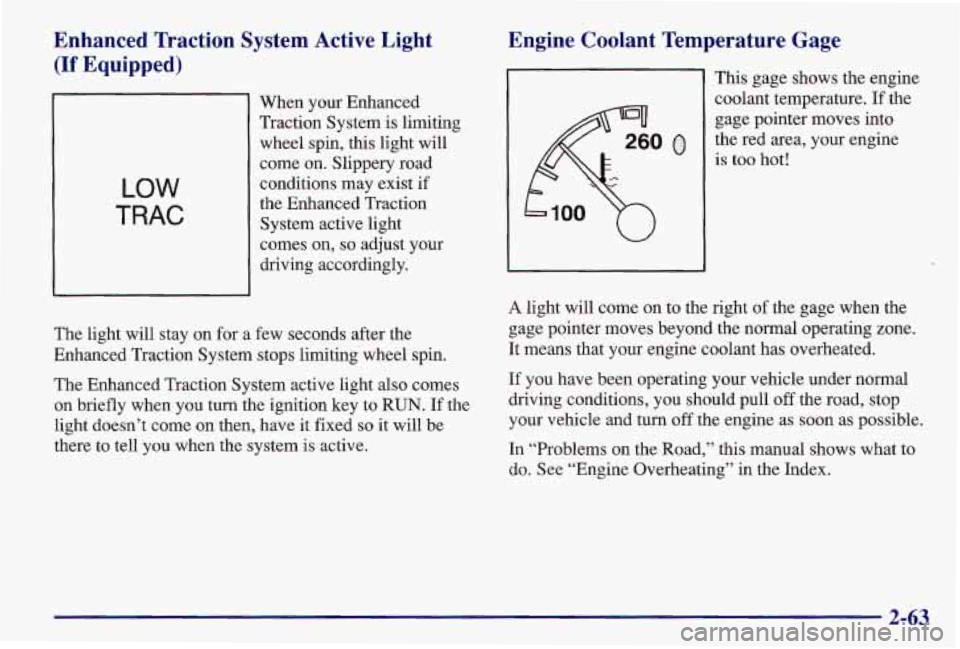
Enhanced Traction System Active Light
(If Equipped)
LOW
TRAC
When your Enhanced
Traction System is limiting
wheel spin, this light will
come on. Slippery road
conditions may exist if
the Enhanced Traction
System active light
comes on,
so adjust your
driving accordingly.
The light will stay on for a
few seconds after the
Enhanced Traction System stops limiting wheel spin.
The Enhanced Traction System active light also comes
on briefly when you turn the ignition key to RUN, If the
light doesn’t come on then, have it fixed
so it will be
there to tell you when the system is active.
Engine Coolant Temperature Gage
This gage shows the engine
coolant temperature.
If the
gage pointer moves into
the red area, your engine
is too hot!
A light will come on to the right of the gage when the
gage pointer moves beyond the normal operating zone.
It means that your engine coolant has overheated.
If you have been operating your vehicle under normal
driving conditions, you should pull off the road, stop
your vehicle and turn off the engine as soon as possible.
In “Problems on the Road,” this manual shows what to
do. See “Engine Overheating” in the Index.
2-63
Page 119 of 371

Low Coolant Warning Light
If this light comes on and
stays on, the vehicle should
be promptly pulled off the
road and the coolant level
checked. See “Engine
Coolant” in the Index.
If there are visible signs of steam see “Engine
Overheating” in the Index before opening the hood.
Malfunction Indicator Lamp
(Check Engine Light)
Your Pontiac is equipped
with a computer which
monitors operation
of the
fuel, ignition and emission
CHECK
ENGINE
This system is called OBD I1 (On-Board
Diagnostics-Second Generation) and is intended to
assure that emissions are at acceptable levels for the life
of the vehicle, helping to produce a cleaner
environment. (In Canada, OBD
I1 is replaced by
Enhanced Diagnostics.) The CHECK
ENGINE light
comes on
to indicate that there is a problem and service
is required. Malfunctions often will be indicated by the
system before any problem is apparent. This may
prevent more serious damage to your vehicle.
This
system is also designed to assist your service technician
in correctly diagnosing
any malfunction.
2-64
Page 126 of 371
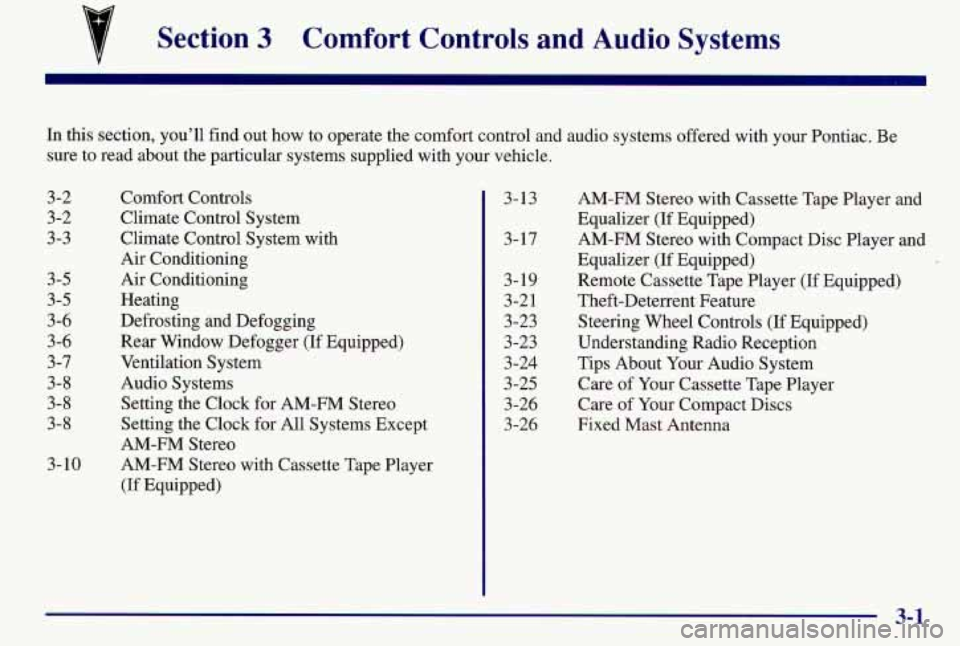
Section 3 Comfort Controls and Audio Systems
In this section, you’ll find out how to operate the comfort control and audio systems offered with your Pontiac. Be
sure to read about the particular systems supplied with your vehicle.
3-2
3-2
3-3 3-5
3-5
3-6 3-6
3-7
3-8 3-8
3-8
3-10 Comfort Controls
Climate Control System
Climate Control System with
Air
Conditioning
Air Conditioning
Heating
Defrosting and Defogging
Rear Window Defogger (If Equipped)
Ventilation System
Audio Systems
Setting the Clock for AM-FM Stereo
Setting the Clock for All Systems Except
AM-FM Stereo
AM-FM Stereo with Cassette Tape Player
(If Equipped) 3-13
3-17
3-19
3-2
1
3-23
3-23
3-24
3
-25
3-26
3-26 AM-FM
Stereo with Cassette Tape Player and
Equalizer
(If Equipped)
AM-FM Stereo with Compact Disc Player and
Equalizer (If Equipped)
Remote Cassette Tape Player
(If Equipped)
Theft-Deterrent Feature
Steering Wheel Controls (If Equipped)
Understanding Radio Reception
Tips About Your Audio System
Care of Your Cassette Tape Player
Care of Your Compact Discs
Fixed Mast Antenna
3-1
Page 127 of 371
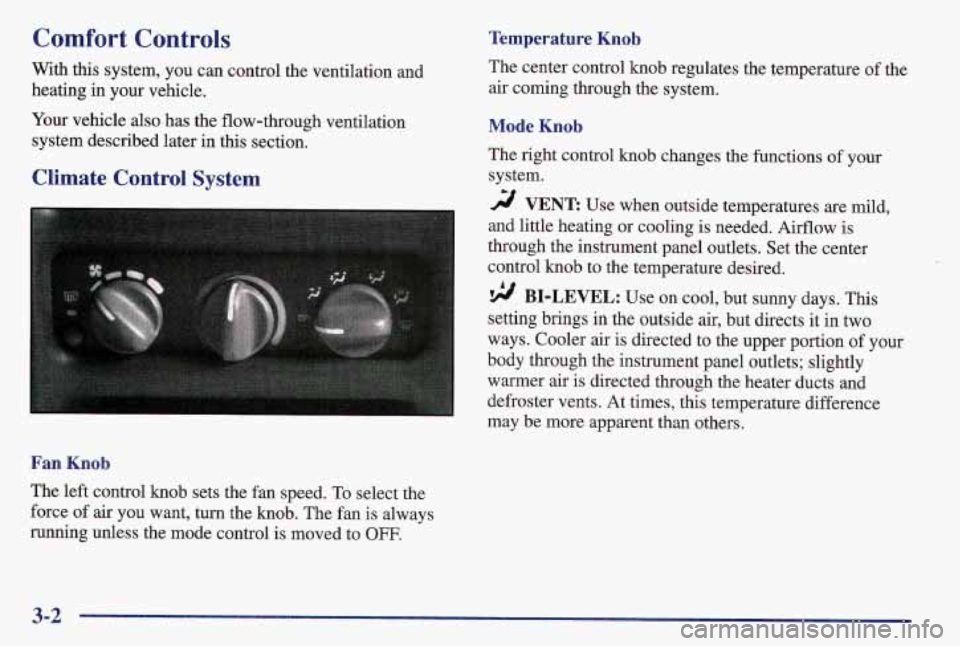
Comfort Controls
With this system, you can control the ventilation and
heating
in your vehicle.
Your vehicle also has the flow-through ventilation
system described later in this section.
Climate Control System
Fan Knob
The left control knob sets the fan speed. To select the
force of air you want, turn the knob. The fan is always
running unless the mode control is moved to
OFF.
Temperature Knob
The center control knob regulates the temperature of the
air coming through the system.
Mode Knob
The right control knob changes the functions of your
system.
2 VENT Use when outside temperatures are mild,
and little heating or cooling is needed. Airflow is
through the instrument panel outlets. Set the center
control knob to the temperature desired.
9 BI-LEVEL: Use on cool, but sunny days. This
setting brings in the outside air, but directs
it in two
ways. Cooler air
is directed to the upper portion of your
body through the instrument panel outlets; slightly
warmer air is directed through the heater ducts and
defroster vents. At times, this temperature difference
may be more apparent than others.
3-2
Page 128 of 371
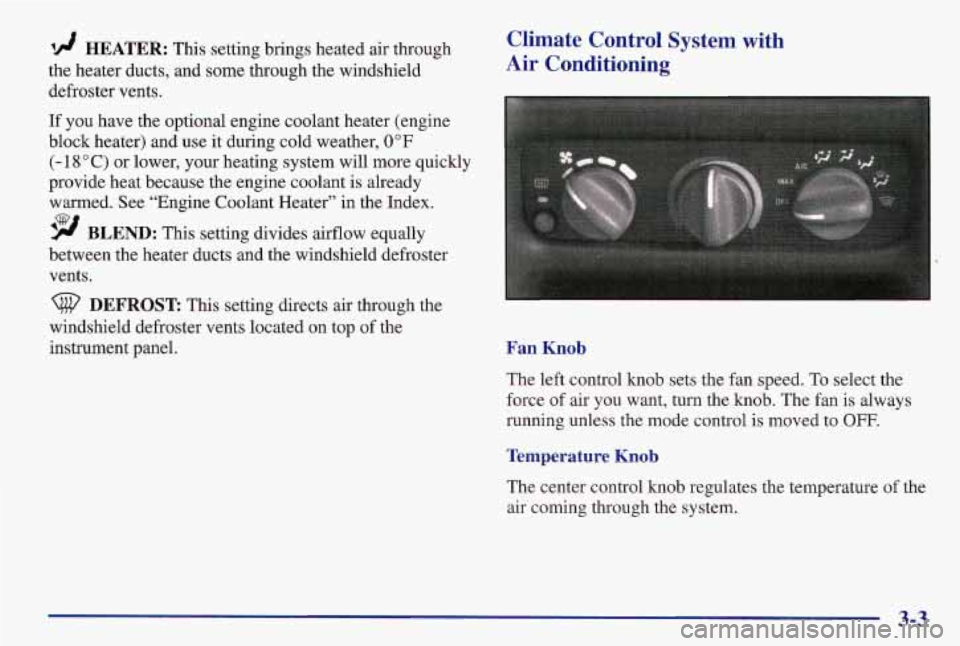
d HEATER: This setting brings heated air through
the heater ducts, and
some through the windshield
defroster vents.
If you have the optional engine coolant heater (engine
block heater) and use it during cold weather,
0°F
(- 18°C) or lower, your heating system will more quickly
provide heat because the engine coolant is already
warmed. See “Engine Coolant Heater” in the Index.
9 BLEND: This setting divides airflow equally
between the heater ducts and the windshield defroster
vents.
DEFROST This setting directs air through the
windshield defroster vents located on top
of the
instrument panel.
Climate Control System with
Air Conditioning
Fan Knob
The left control knob sets the fan speed. To select the
force of air
you want, turn the knob. The fan is always
running unless the mode control is moved
to OFF.
Temperature Knob
The center control knob regulates the temperature of the
air coming through the system.
3-3
Page 129 of 371
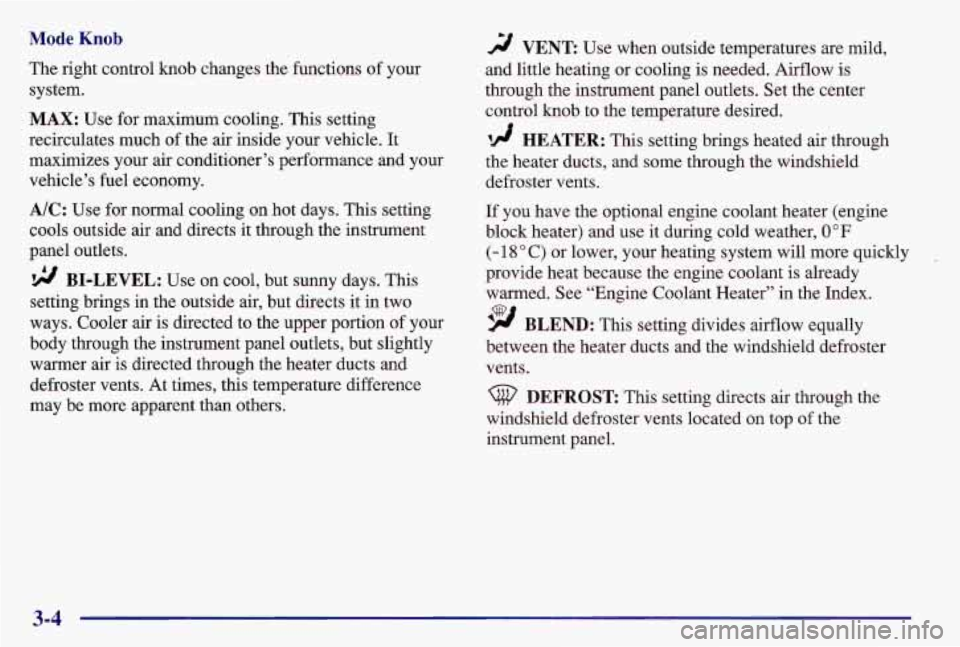
Mode Knob
The right control knob changes the functions of your
system.
MAX: Use for maximum cooling. This setting
recirculates much of the air inside your vehicle. It
maximizes your air conditioner’s performance and your
vehicle’s fuel economy.
A/C: Use for normal cooling on hot days. This setting
cools outside air and directs it through the instrument
panel outlets.
9 BI-LEVEL: Use on cool, but sunny days. This
setting brings in the outside air, but directs it in two
ways. Cooler air is directed to the upper portion
of your
body through the instrument panel outlets, but slightly
warmer air is directed through the heater ducts and
defroster vents. At times, this temperature difference
may be more apparent than others.
2 VENT Use when outside temperatures are mild,
and little heating or cooling is needed. Airflow is
through the instrument panel outlets. Set the center
control knob to the temperature desired.
‘!A HEATER: This setting brings heated air through
the heater ducts, and some through the windshield
defroster vents.
If you have the optional engine coolant heater (engine
block heater) and use it during cold weather,
0°F
(- 18 O C) or lower, your heating system will more quickly
provide heat because the engine coolant is already
warmed. See “Engine Coolant Heater” in the Index.
9 BLEND: This setting divides airflow equally
between the heater ducts and the windshield defroster
vents.
DEFROST This setting directs air through the
windshield defroster vents located on top of the
instrument panel.
3-4